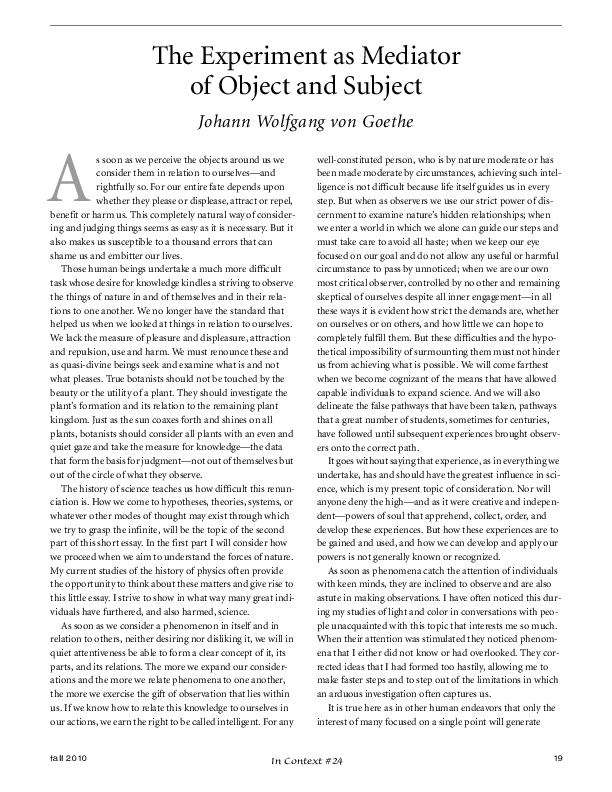Mini-workshop:
Experiment
Doel: verschillende manieren/versies onderzoeken met ruimte voor toeval
Oefening:
Pak een aspect van je onderzoeksopzet (bijvoorbeeld documentatie, observatie);
- Kies een concreet object of situatie om mee te experimenteren
- beschrij fje doel
- beschrijf de setting (bordering phenomena. vaste en variabele factoren)
- bepaal en beschrijf de testvariabelen en de instelling (variaties) waarmee je kan experimenteren
testvariabele - wisselt
controlevariabelen - vast
Analyseren:
Once we have carried out an experiment, we cannot be careful enough to examine other bordering phenomena and what follows
next.
Reflecteren:
Once, however, we have brought together a series of experiences of a higher kind, we can apply intellect, imagination and ingenuity as we like.
The Experiment as Mediator
of Object and Subject
Johann Wolfgang von Goethe
In Context #24 (Fall, 2010, p.p. 19-23); copyright 2010 by The Nature Institute
As artists we do well not to show our products
to the public until they are completed, because no one can easily give advice or provide assistance.
In scientific matters,by contrast, it is useful to publicly communicate every experience, every conjecture.
Every single experience, every single experiment through which we reproduce that experience, is essentially an isolated piece of knowledge and through carrying out the experiment a number of times we verify it as such.
While we can praise a single experiment, it gains its true value only through its connection and unification with other experiments.
As soon as we consider a phenomenon in itself and in
relation to others, neither desiring nor disliking it, we will in quiet attentiveness be able to form a clear concept of it, its parts, and its relations.
On the one hand, every experience, every experiment is
by its very nature isolated. On the other hand, the power of the human mind seeks to unite with tremendous force all that it meets in the outer world. Considering all this, we can easily see the danger of connecting an individual experience with a preconceived idea, or of wanting to prove by means of individual experiments relations that are not altogether sense perceptible — that the creative power of thought has already formulated.
Higher order experiences are based on numerous individual experiments that can be investigated
and tested by anyone.
Once, however, we have brought together a series of experiences of a higher kind, we can apply intellect, imagination and ingenuity as we like.
“inquiry-based” learning whereby students experience science as a process of exploration.
creating a series of experiments that contain an array of variations so that we
begin to unveil the phenomena through a many-sided consideration. In this movement through the phenomena and
their variations, an order can begin to appear and patterns or relationships show themselves.
This is a seeing of relationships—inner lawfulness—that arises out of the
engagement with the phenomena.
we cannot be careful enough to
examine other bordering phenomena
The question is: how
do we find the connections between phenomena or within a
given situation?


